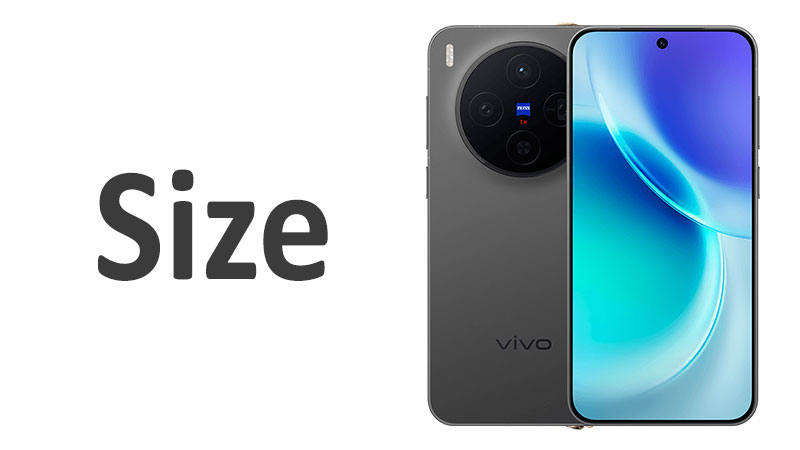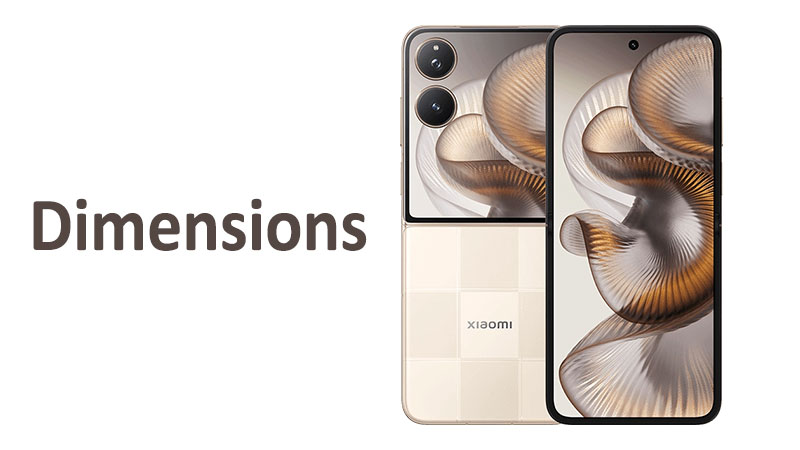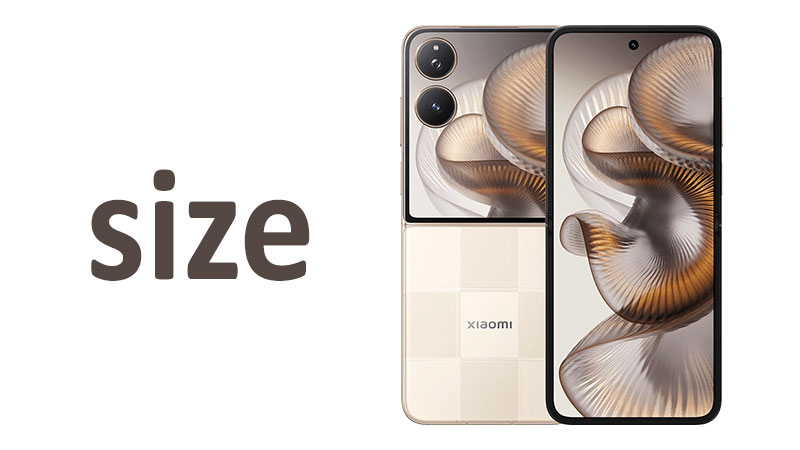The vivo X300 Size and physical form factor are critical selling points for many consumers. Flagship phones often prioritize massive screens, leading to unwieldy devices. The base vivo X300 takes a distinctly different approach. It balances a high-quality display with genuine one-handed usability. This choice makes it an attractive option for buyers seeking portability. We will conduct a thorough review of the phone’s precise measurements. This analysis includes the screen size, height, width, and thickness. It also provides important comparisons to its larger Pro sibling and key market rivals. Understanding these dimensions helps users gauge daily comfort and handling security.
The Compact Display: 6.31 inches for Usability
The vivo X300 features a 6.31 inch screen size. This measurement immediately signals its focus on ergonomics. While still a large display, it is significantly smaller than the screens on most modern flagships. This size is specifically chosen to improve reachability. It ensures most users can comfortably navigate the entire screen. The total screen surface area is approximately 98.0 cm2. This provides ample space for all common applications.
This 6.31 inch panel offers an excellent balance. It provides a highly immersive experience without overwhelming the user’s hand. Text remains sharp and media consumption is satisfying. However, the true benefit is the enhanced control. Single-handed scrolling and typing become effortlessly easy. The display size is a statement against the current trend of excessive mobile dimensions. It champions comfortable interaction.
Specialized Comparison: The Compact Advantage
The 6.31 inch display is noticeably smaller than the 6.78 inch screen of the vivo X300 Pro. This is a crucial distinction between the two models. The base X300 targets users who prioritize portability. The X300 Pro targets those who prioritize maximum visual space. The size is comparable to other market compact flagships. These typically hover around the 6.2 inch to 6.4 inch range.
The previous generation vivo X200 likely featured a similar or marginally smaller screen. The X300 maintains this comfortable form factor. It resists the urge to inflate dimensions dramatically. This consistency is highly appreciated by users upgrading from older, smaller phones. It minimizes the adjustment period for daily use. This display size caters directly to the compact segment of the market.
Pros and Cons of a 6.31 inch Screen
The primary pro is the superior single-handed usability. Users can easily access notifications and quick settings with their thumb. The smaller physical footprint increases pocketability significantly. Furthermore, the glass surface area is reduced. This inherently lowers the risk of screen breakage if the phone is dropped.
The main con is the reduced visual immersion for media. While excellent, the screen is less expansive than its larger rivals. Gamers and professional video editors may prefer a larger canvas. Multitasking in split-screen mode is functional but feels slightly more constrained. This trade-off prioritizes comfort over sheer visual scale.
Buyer’s Consideration: Prioritizing Portability
A reader should view the 6.31 inch size as a clear design choice. This phone caters directly to users tired of cumbersome devices. If you spend significant time using your phone while walking or commuting, this size is ideal. The comfort provided by the smaller screen is a daily ergonomic benefit. Do not select this phone if a truly cinematic screen is your absolute highest priority.
The Exterior Dimensions: 150.6 mm Height Analysis
The total height of the vivo X300 measures 150.6 mm, or 5.93 inches. This is a notably shorter vertical measurement compared to current market flagships. This height is essential for enhancing one-handed interaction. A shorter phone chassis keeps the upper edge of the display within closer reach. This is important for reaching elements like the notification bar.
The 150.6 mm height is optimized around the 6.31 inch screen. Minimal top and bottom bezels ensure the phone is not wasted space. The shorter length dramatically improves how the phone sits in pockets. It minimizes the risk of the phone protruding or falling out. The dimensions reflect a highly compact and deliberate design philosophy.
Specialized Comparison: Pocketability
The X300’s 150.6 mm height is significantly shorter than the X300 Pro’s 161.2 mm height. This difference of over 10 mm makes a massive difference in daily handling. The Pro model is clearly a very tall device. The base X300 is comparatively short and easily managed. Most rival flagships exceed 155 mm in length. This gives the X300 a distinct advantage in pocketability.
Older models in the compact category may have similar heights. The X300 manages to include a modern, high-capacity battery within this short chassis. This shows excellent internal component arrangement. The short height is a strong feature for users constantly on the move.
Pros and Cons of 150.6 mm Height
The main pro is the superb pocket fit. The phone sits securely in almost all pocket types, including smaller shirt pockets. The reduced length also makes the phone less top-heavy. This improves grip security and prevents accidental drops. Reaching across the screen’s vertical axis is easier for most users.
A minor con is the limited internal space for extreme componentry. The shorter length restricts the potential size of the internal camera system. However, the 8 mm thickness helps compensate for this internal space limitation. This is a small trade-off for the increased portability.
Buyer’s Consideration: Daily Mobility
Buyers should consider the 5.93 inch height benefit for daily mobility. If you frequently find current smartphones too long, the X300 is a perfect counterpoint. The height makes accessing the entire screen much less strenuous. This single dimension alone can define the user experience for many compact phone enthusiasts. It represents excellent design efficiency.
Grip and Width: 71.9 mm Across for Security
The width of the vivo X300 is 71.9 mm, or 2.83 inches. This horizontal measurement is arguably the most important factor for secure one-handed holding. A width of 71.9 mm is considered the gold standard for comfortable, compact devices. It ensures that the user’s thumb can easily sweep across the entire screen. This width is crucial for typing and navigational input.
The narrow profile is essential for maintaining control and grip security. A phone this narrow feels secure in the hand. It minimizes the chance of the phone slipping out. The overall girth is perfectly suited for extended periods of use. This width is a clear indication that ergonomic comfort was a top design priority.
Specialized Comparison: One-Handed Use
The X300’s 71.9 mm width is significantly narrower than the X300 Pro’s 75.5 mm width. This 3.6 mm difference is highly noticeable in hand. The Pro requires a definite stretch for thumb access. The base X300 allows for much easier, unrestricted thumb movement. This makes it a superior device for single-handed typing.
Most competitors with 6.7 inch screens exceed 74 mm in width. The X300 is competitive with, or even narrower than, many smaller 6.1 inch rival devices. This exceptionally narrow profile sets it apart in the flagship segment. It establishes the X300 as the leading option for compact comfort.
Pros and Cons of 71.9 mm Width
The major pro is the unparalleled one-handed grip security and comfort. Users can confidently hold the phone without fear of dropping it. Typing with one thumb is fast and highly accurate. The narrow dimensions also make the phone feel highly manageable and portable. This is a significant advantage in crowded environments.
The only con is the keyboard width. The on-screen keyboard is slightly narrower than that of the X300 Pro. Users accustomed to extremely wide keyboards may require a short adjustment period. This is a very minor issue for the vast majority of users, however. The benefit of better grip far outweighs this slight keyboard difference.
Buyer’s Consideration: Ergonomic Priority
Potential buyers should prioritize the 71.9 mm width if they value grip and security. This dimension allows for genuine one-handed use throughout the day. Using a slim case will only marginally increase the width. This ensures the phone remains secure in almost all hand sizes. The X300 is the ideal choice for those focused on ergonomic excellence.
Sleekness and Ergonomics: The 8 mm Thickness
The thickness of the vivo X300 is a slim 8 mm, or 0.31 inches. This measurement is identical to the thickness of the larger X300 Pro. Maintaining this thin profile on the smaller body enhances the perception of sleekness. It allows the phone to feel exceptionally slender and refined. The 8 mm thickness contributes significantly to the overall aesthetic appeal.
Achieving 8 mm thickness requires efficient internal component design. The phone must house its battery and camera modules within this tight space. The slim profile ensures the X300 slides effortlessly into pockets and bags. It is a key element in the phone’s commitment to portability. Thinness is universally recognized as a premium design trait.
Specialized Comparison: Thickness Uniformity
The X300 maintains the same 8 mm thickness as the X300 Pro. This shows a uniform design philosophy across the flagship line. This common thickness allows for shared design language and accessories. It is also significantly thinner than many competitor flagships. Rivals often exceed 8.5 mm due to large battery requirements. The X300 achieves excellent battery life despite its thin frame.
The slimness is highly competitive with other thin-focused flagships. It achieves this without compromising the structural integrity of the smaller chassis. The construction materials must be robust to maintain rigidity at this thinness. The X300 offers a sleek, comfortable, and thin profile.
Pros and Cons of 8 mm Thickness
The most clear pro is the superior feel in hand. The phone feels light and comfortable for long phone calls or extended browsing sessions. The thin profile minimizes bulk when the phone is carried in clothing. This is a huge benefit for users who dislike bulky devices.
The main con, as with the Pro model, is the camera module protrusion. The advanced sensors still require extra depth. This depth extends beyond the 8 mm body. This results in a notable camera bump on the back surface. The bump causes the phone to be unstable when placed on a flat desk. This slight instability is a necessary compromise for camera technology.
Buyer’s Consideration: Balanced Design
A buyer should acknowledge the thinness is a major design success. The 8 mm profile makes the phone feel exceptionally modern and premium. If you plan to use a thin case, the camera wobble will be negated. The case will slightly increase the thickness. However, the total thickness remains highly manageable compared to thicker rivals. The X300 delivers premium feel and function at this 8 mm measurement.
Bezel Optimization: 90.5% Screen-to-Body Ratio
The vivo X300 achieves an impressive ∼90.5% screen-to-body ratio. This metric confirms the minimal size of the bezels surrounding the display. A high ratio is critical for maximizing the visual impact of the 6.31 inch screen. It ensures the phone’s footprint is dominated by the active display area. The bezels are incredibly slim on all four sides.
This 90.5% ratio demonstrates highly efficient design. It ensures that the compact phone feels visually expansive. The content extends right to the edges of the frame. This minimal framing maximizes the available screen space. It provides a truly modern, edge-to-edge viewing experience for the user.
Specialized Comparison: Design Efficiency
The X300 Pro achieves a slightly higher 91.6% ratio due to its larger canvas. However, the X300’s 90.5% ratio is still excellent for a compact device. Achieving this high ratio on a smaller screen is technically demanding. It requires precision engineering to minimize the display borders. Many rival compact phones sacrifice bezel size for lower costs. The X300 maintains flagship-level bezel reduction.
This ratio makes the phone look visually striking and sophisticated. It confirms that the X300 is not a compromise device. It is a full-featured flagship in a smaller package. This high screen-to-body ratio improves the phone’s aesthetic appeal substantially.
Pros and Cons of a High Ratio
The major pro is the visual quality of the display. The minimized bezels allow for maximum focus on the content itself. This makes the 6.31 inch screen feel much larger than its diagonal measurement suggests. The phone appears sleek and highly contemporary due to this design.
A minor con, common with all high-ratio designs, is potential accidental touch activation. The user’s palm may occasionally brush the screen edges during single-handed use. Vivo’s operating system must include sophisticated palm rejection algorithms. This is essential to prevent frustrating unintended inputs. Screen repairs may also be slightly more complex due to the minimal framing.
Buyer’s Consideration: Seamless Aesthetics
Buyers appreciate the 90.5% screen-to-body ratio for its aesthetics. It gives the phone a premium, modern feel. Ensure you check for effective palm rejection in user reviews. This guarantees a seamless user experience despite the minimal bezels. The high ratio proves that a compact phone can still offer a truly immersive display.
Conclusion: An Informed Decision on the X300 Size
The vivo X300 Size and dimensions define its purpose. It is a champion of the compact flagship segment. The phone measures 150.6×71.9×8 mm (5.93×2.83×0.31 in). It features a highly usable 6.31 inch screen with a 90.5% screen-to-body ratio.
This combination of dimensions is ideal for users prioritizing one-handed comfort and portability. The 71.9 mm width ensures a secure and comfortable grip. The 150.6 mm height guarantees easy pocketability. The 8 mm thickness maintains a sleek, premium feel.
The X300 stands in stark contrast to the large-format Pro model. It serves as the perfect alternative for users with smaller hands. It is also great for anyone who finds current flagships too cumbersome. This phone is an excellent choice for daily mobility, easy pocket carry, and effortless interaction. Buyers seeking maximum screen size should choose the X300 Pro. Those who value a perfect balance of power and pocket-friendly size should choose the vivo X300.
Frequently Asked Questions (FAQ)
1. Is the vivo X300 easy to use with only one hand?
Yes, the 71.9 mm width makes the vivo X300 exceptionally comfortable for one-handed use and typing.
2. Is the vivo X300 size smaller than the X300 Pro?
Yes, the X300 is significantly smaller. It measures 150.6 mm tall compared to the Pro’s 161.2 mm height.
3. What is the diagonal measurement of the screen?
The screen size is 6.31 inches. This offers a large viewing area while maintaining a compact phone profile.
4. How does the thickness compare to other flagships?
At 8 mm thick, the X300 is notably thinner than most competitor flagships, enhancing its sleek feel.
5. Is the X300 truly pocket-friendly for all users?
Yes, the compact 150.6 mm height ensures the X300 fits securely and easily in nearly all standard pockets.



